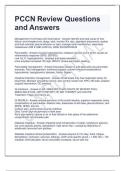PCCN Review Questions
and Answers
Management of Cirrhosis and renal failure - Answer-Identify and treat cause of liver
failure, avoid hepato-toxic drugs, etoh, monitor lft's, abc, aspiration pneumonia, ascites
and fluid overload, pleural effusion on right, manage renal insufficiency, electrolyte
imbalances LOW K AND LOW CA, HIGH PHOSPHORUS
Pancreatitis - Answer-Causes hypocalcemia, releases necrotic toxins which causes an
inflammatory response (SIRS, SEPSIS).
Low Ca, K, hyperglycemia , amylase and lipase elevated,
urine amylase increased, lfts high, MRI/CT shows pancreatic swelling
Pancreatitis management - Answer-Decrease release of and destruction by pancreatic
enzymes. Pain management, nutritional support, prevent infection/complications-
hypovolemia, hypoglycemia, abscess, fistula, Sepsis
Intestinal infarction management - Answer-Small bowel only has mesenteric artery for
blood flow. Maintain circulating volume, pain control, bowel rest, NPO, NG tube, prepare
surgical intervention, DC pressors
GI infections - Answer-C-diff- GREATER THAN 3 DAYS OF WATERY FOUL
SMELLING STOOL, WITH HISTORY OF ABT THERAPY and COLITIS
Treatment- Flagyl and Vanco po
GI PEARLS - Answer-arterial perfusion of the small intestine: superior mesenteric artery
complications of pancreatitis- bilateral riles, atelectasis of left base, pleural effusion, and
ARDS, HHNK, low CA
Cullen's sign- ecchymosis around umbilicus
Grey Turner Sign-ecchymosis in flank area
Ker's sign-splenic rupture or air or fluid (blood) in free space of the abdominal
compartment- left shoulder pain
Diabetes Insipidus - Answer-Impaired renal conservation of water, resulting in polyuria,
low urine specific gravity, dehydration, high serum Na+- caused by deficiency of
antidiuretic hormone from pituitary
Diabetes Insipidus clinical presentation - Answer-polyuria 5-15 L/day, thirst, fatigue,
dehydration, confusion, seizures, lethargy, LOW urine specific gravit < 1.005, NA > 145
meq/liter, BUN elevated, serum osmolality increased, serum adh low
, Treatment- correct fluid deficit, hypotonic solutions, Vasopressin (ADH hormone),
correct fluid deficit, DDAVP, Diapid
Syndrome of Inappropriate Antidiuretic Hormone (SIADH) - Answer-impaired renal
excretion of water, resulting in oliguria, high urine specific gravity, water intoxication,
and hyponatremia
Caused by neuro, oat cell cancer,anesthesia, narcotics, HYPOXIA, STRESS,
MULTIFACTORIAL IN ICU
Clinical presentation and treatment of SIDH - Answer-Oliguria 0.5 mL/kg/hr, urine
specific gravity >1.030, volume overload, BUN, serum osmolality, NA decreased 120
meq/liter, ADH increased. HA, Seizures, LOC changes, pulmonary edema, Seizures,
muscle weakness, Fluid overload.
Treat cause-remove malignancy, decrease water intake, dc drugs that cause SIDH,
diurectics, hypertonic solutions if NA < 125 or seizures
DKA - Answer-Glucose 300-600
Normal Na
K elevated but decreases with insulin administration
Ketones are present
BUN/Creatinine ration is elevated
WBC may be elevated
Serum osmolality is elevated= 295-330
ABG's indicate metabolic acidosis
N/V, abdominal pain, polyphagia, polydipsia, polyuria. weakness, fatigue, dehydration
with tachycardia, orthostatic hypotension
Lethargy
Kussmaul respirations
DKA treatment - Answer-Monitor ABC's
Identify and treat cause- blood cultures for infection
Correct fluid volume deficit
Normalize glucose- 0.1-0.15 units/kg, follow by infusion
GLUCOSE SHOULD DROP NO MORE THAN 75-100mg/dL/hour to avoid
HYPOGLYCEMIA, HYPOKALEMIA, CEREBRAL EDEMA
replace electrolytes
correct acid base balance
HHNK: Hyperglycemia hyperosmolar non-ketotic conditon - Answer-Glucose 600-2000
Na is low
K is low
BUN/Creatinine high
serum osmolality high 330-450
ABG is normal ph- consider lactic acidosis if normal
Treatment HHNK - Answer-Identify cause- infection?




